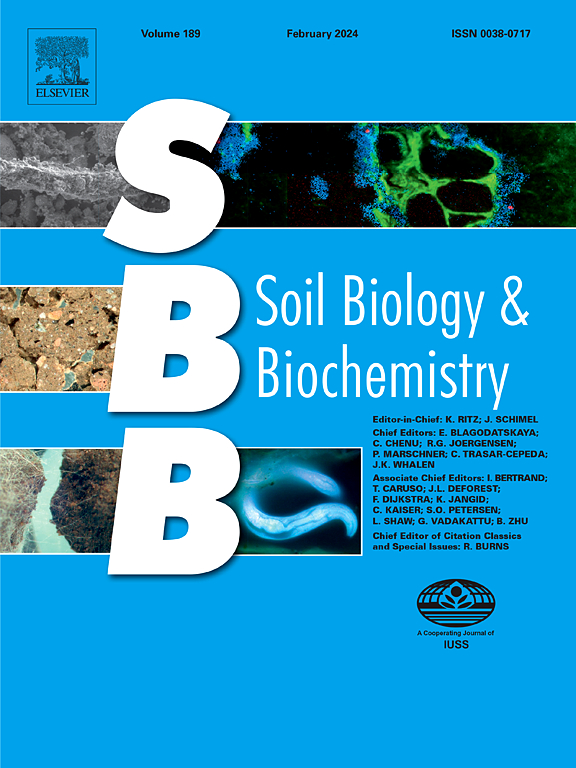干旱后有机碳矿化导致多年生草地在复湿后具有较高的生产力和养分吸收效率
IF 10.3
1区 农林科学
Q1 SOIL SCIENCE
引用次数: 0
摘要
草原往往从干旱中恢复得很好,有些甚至在干旱解除后很长一段时间内超过了非干旱胁迫控制的生产力。然而,造成这种干旱后生产力优异表现的机制尚不清楚。在这项研究中,我们研究了干旱后的再湿润如何影响重要的短期和长期土壤微生物过程(即氮矿化,潜在的酶活性)以及随之而来的植物养分可用性和吸收。为此,建立了一个大田试验,在不同氮肥水平下,对已建立的多年生黑麦草进行了为期2个月的夏季干旱再湿润试验和雨养对照试验。干旱后的再湿润导致总n矿化和nh4消耗率的立即脉冲。与干旱期间未施氮和未施氮的对照区相比,以前受干旱胁迫的亚区这两个比率分别提高了230%和430%。重要的是,干旱结束时,总氮矿化率与可提取土壤有机碳含量显著相关。与此同时,干旱和复湿在复湿后第1个月显著提高了NO3-N、P、K、S、Fe、Zn和Mn的有效性,但除K外,在复湿后第2个月没有显著提高,多年生黑麦草地上生产力在复湿后第1个月对NO3-N有效性做出了积极响应,导致干旱胁迫地块的生产力表现优于对照。这些结果表明,多年生草地在复湿后第1个月的短期生产力表现是由干旱期间积累的有机基质氮矿化脉冲引起的NO3-N有效性增加所驱动的。虽然干旱和复湿对养分有效性的影响仅在复湿后的第1个月出现,但草地生产力在复湿后的第2个月持续表现优异。这表明土壤干旱遗产增加了植物养分吸收效率,解释了当干旱和再湿润对养分有效性的影响不再明显时的长期优异效应。本文章由计算机程序翻译,如有差异,请以英文原文为准。
Post-drought organic carbon mineralization leads to high productivity and nutrient uptake efficiency of perennial grassland after rewetting
Grasslands often recover well from drought, with some even surpassing non-drought-stressed controls in productivity long after drought release. However, the mechanisms responsible for such post-drought productivity outperformance remain unclear. In this study we examine how rewetting after drought influences important short- and longer-term soil microbial processes (i.e. nitrogen mineralization, potential enzyme activities) and consequent plant nutrient availability and uptake. For this, a field experiment was set up where an established perennial ryegrass sward under different N-fertilization levels was subjected to either a 2-month experimental summer drought followed by rewetting or to rainfed control conditions.
Rewetting after drought led to an immediate pulse in gross N-mineralization and NH4-consumption rates. Both rates increased by >230% and >430% in formerly drought-stressed subplots compared to controls in plots not N-fertilized and N-fertilized during drought, respectively. Importantly, gross N mineralization rates correlated significantly with extractable soil organic carbon contents at the end of drought. Concurrently, drought and rewetting significantly increased NO3–N, P, K, S, Fe, Zn, and Mn availability during the 1st but not the 2nd month after rewetting, except for K. Aboveground productivity of perennial ryegrass responded positively to NO3–N availabilities during the 1st month after rewetting, leading to productivity outperformance of formerly drought-stressed plots compared to controls. These results suggest that short-term productivity outperformance of perennial grasslands in the 1st month after rewetting is driven by an increase in NO3–N availability caused by a rewetting-induced pulse in N-mineralization of organic substrates accumulated during drought. Although effects of drought and rewetting on nutrient availability were only observed in the 1st month after rewetting, grassland productivity outperformance persisted in the 2nd month after rewetting. This indicates that soil drought legacy increased plant nutrient uptake efficiency, explaining longer-term outperformance effects when effects of drought and rewetting on nutrient availability were no longer apparent.
求助全文
通过发布文献求助,成功后即可免费获取论文全文。
去求助
来源期刊

Soil Biology & Biochemistry
农林科学-土壤科学
CiteScore
16.90
自引率
9.30%
发文量
312
审稿时长
49 days
期刊介绍:
Soil Biology & Biochemistry publishes original research articles of international significance focusing on biological processes in soil and their applications to soil and environmental quality. Major topics include the ecology and biochemical processes of soil organisms, their effects on the environment, and interactions with plants. The journal also welcomes state-of-the-art reviews and discussions on contemporary research in soil biology and biochemistry.
 求助内容:
求助内容: 应助结果提醒方式:
应助结果提醒方式:


